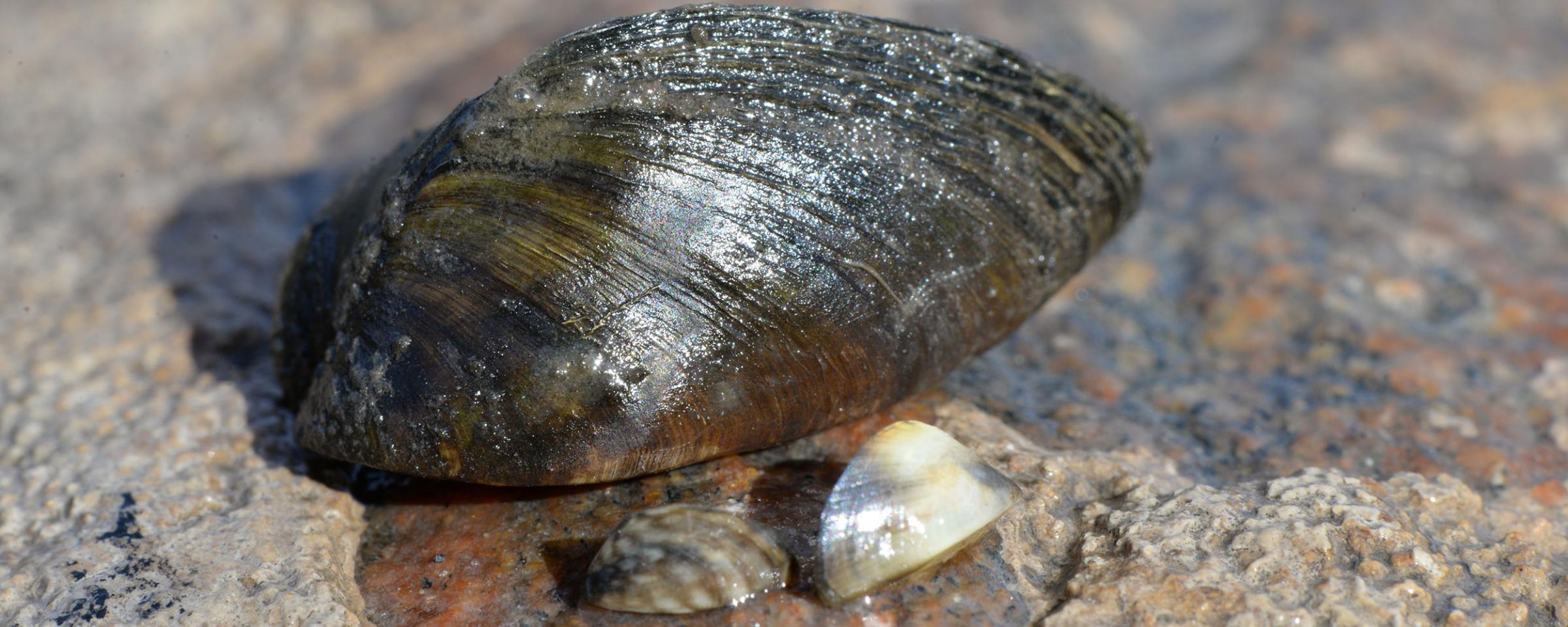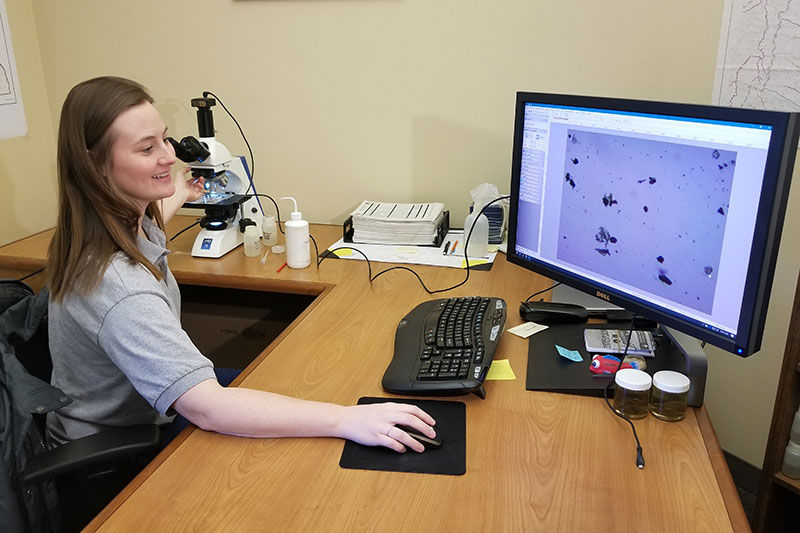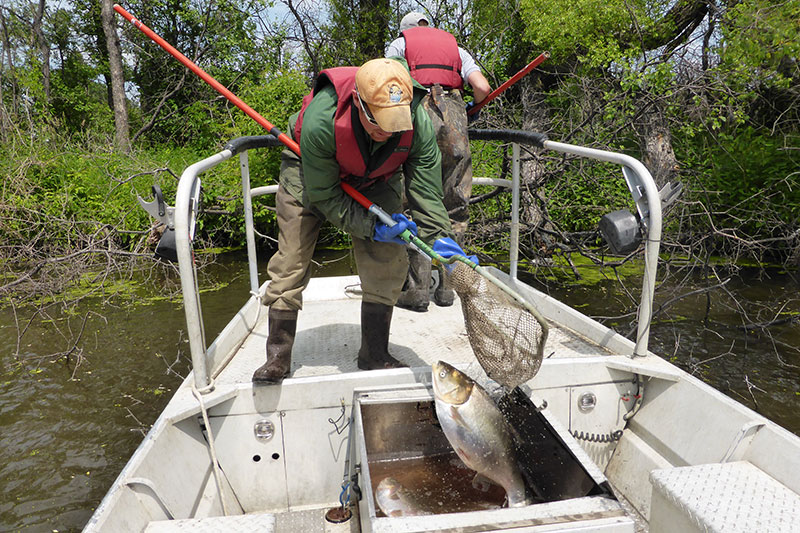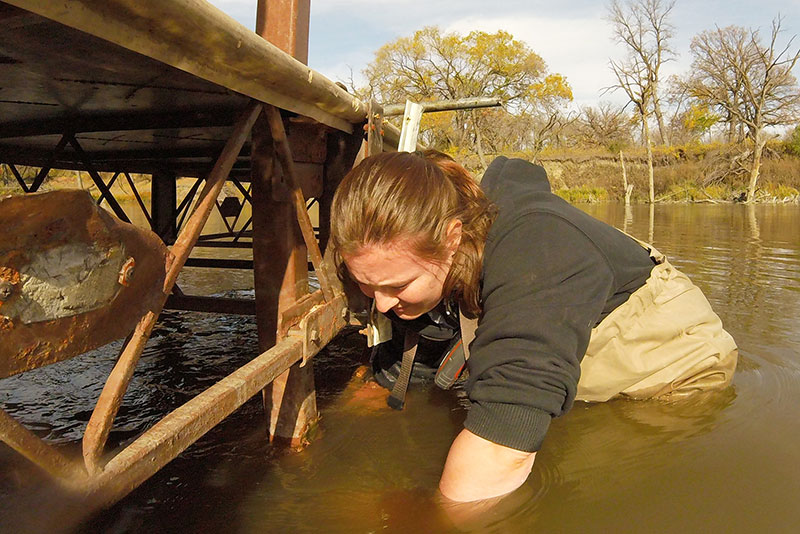
Planning for Success: Updating the ANS Management Plan
When I tell people I work with aquatic nuisance species, I typically get: “You mean, like, zebra mussels?”
Surveys show that more than 95 percent of boaters have heard of zebra mussels and around 80 percent are familiar with other ANS, such as silver carp or curly leaf pondweed.
Is it enough that more than 90 percent say they take actions to prevent the spread of invasive species at least occasionally?

Jessica Howell, Department aquatic nuisance species coordinator, searches for tiny zebra mussel veligers on her computer monitor. Enlarging water samples with a microscope makes it easier to spy the miniscule veligers.
But is it enough that boaters and anglers have heard about ANS?
At the North Dakota Game and Fish Department, we don’t think it is.
Aquatic nuisance species come in many shapes and sizes; some are harder to kill than others. On top of that, there are many, many ways that ANS can spread.
It’s true that North Dakota waters receive a lot of fishing pressure, especially from anglers using boats. It’s estimated these anglers launch their boats more than 600,000 times in any given year. With many boaters traveling back and forth from infested waters in North Dakota and surrounding states, there is a risk of ANS hitchhiking on equipment or in water.
But putting the entire burden of ANS prevention on anglers and boaters isn’t fair. Game and Fish is also concerned that people who own aquatic pets don’t know where to get rid of them, or that anyone who orders aquatic plants or animals online can unknowingly actually buy invasive species. Pathways like these and others still need addressing.
That’s why the Game and Fish Department doesn’t just focus on boaters and anglers. The agency tries to prevent several types of ANS, from fish to plants, from introduction through an array of pathways. This means there is a need to expand efforts beyond boaters and anglers and work to prevent the spread on many different fronts. This includes overseeing inspections of barges and other commercial equipment that are headed to North Dakota waters from areas often infested with ANS.
The Department also focuses on controlling species already in North Dakota to reduce negative impacts on recreation, the economy or ecosystems.
Game and Fish has a set amount of resources to dedicate to preventing the introduction and spread of ANS. To help prioritize how to best use those resources, it has an ANS management plan, which guides efforts in North Dakota that are conducted by state, tribal, local and private interests.
The first plan was finalized and adopted in 2005. At the time, the Game and Fish Department was the primary entity driving plan development. The 2005 plan drew heavily on current knowledge from other states, which was limited. Zebra and quagga mussels were a major driver in decisions, but most of the experience in the U.S. with those species came from the Great Lakes. There was much that was not yet known about the biology of these species or effective ways to stop their spread, and even less known about other aquatic nuisance species of concern.
North Dakota didn’t have much first-hand experience with ANS in 2005 outside of common carp, a few records of curly leaf pondweed, and the thought that grass carp were finally dying out of Spiritwood Lake. The state didn’t even have a list of aquatic nuisance species of concern.
Some of the first actions called for by the 2005 plan were to establish a statewide committee on ANS, develop an ANS list for the state, and adopt regulations to protect against new introductions or spread. These basic building blocks took time to accomplish, but set the foundation for a strong program in North Dakota.

Game and Fish Department personnel net invasive silver carp on the James River.
Shortly after the original plan was signed in February 2005, the Game and Fish Department dedicated resources to an ANS program to follow through with the actions identified in the plan. This included a half-time ANS coordinator and shifting a small amount of fisheries money to do ANS work as needed. A small annual grant from the U.S. Fish and Wildlife Service that was tied to the adopted plan also assisted ANS efforts in North Dakota.
Legislation and administrative rules followed shortly thereafter, one of which established the statewide ANS committee. This committee is comprised of state, tribal, nonprofit and private interests to advise on ANS efforts. It was this committee that helped establish the ANS list for North Dakota and guide regulation development in the beginning of the ANS program.
Since 2005, populations of Eurasian water milfoil, silver carp and zebra mussels have showed up after the original plan was approved. Neighboring states learned valuable lessons they were able to share about other ANS that North Dakota does not have, including what worked and didn’t work after years of managing species relatively new to North Dakota.
Today, ANS knowledge has advanced, including biology and how species can spread, as well as more complex matters, such as how to inform users more effectively or implement useful regulations without being overbearing. This information has slowly transformed how North Dakota prioritizes ANS efforts and has encouraged more collaboration among various agencies and entities in the state.
Annual planning is conducted by the ANS committee, which meets twice a year. In spring, members talk about their plans for the year and potential changes. Spring is also a good time to review results from the previous year that took time to analyze, especially lab results. In fall, any changes to the ANS list can be discussed as members report on how the season went and what work was completed.
In 2018, Game and Fish decided to update its management plan to reflect this slow evolution of ANS management efforts. The statewide ANS committee was instrumental in this effort, building on experience and knowledge gained in the 13 years since the original plan was developed.
After several rounds of edits and input from stakeholders, a final plan was approved first by the state ANS committee in November and then by Governor Doug Burgum in December 2018. A copy of the plan is posted on the North Dakota Game and Fish website at gf.nd.gov/ans.
The recent update streamlined the original plan, cutting total pages from 205 to 29 and halving the objectives, strategies and actions by eliminating redundancies. It also updated information on ANS currently found in North Dakota and incorporated advances in management techniques learned over the years.

Jessica Howell, Department aquatic nuisance species coordinator, inspects a dock on the Red River for zebra mussels.
The simplified and updated plan increases effectiveness because the committee can now easily read through the entire plan, or find relevant sections. This allows for more discussion of priorities based on what’s identified in the plan. The update also included the addition of a table that lists potential actions, ranks them by priority, and recommends how often they should be completed. If more resources become available, new efforts can be quickly identified using this table and the supporting text.
Perhaps most importantly, though, periodic evaluations were included in the actions, and established that the plan will need updating every five years. This will help agencies adjust as research and experience advances the understanding of current and future ANS threats.
The overall goal is still to prevent introductions of new ANS, prevent spread of existing populations, eradicate populations when feasible, and to mitigate effects of populations on the ecosystem, economy and recreation when possible. That’s a hefty charge, and one that the Game and Fish Department takes seriously.
But Game and Fish can’t do it alone. The Department works with partners like the state ANS committee, federal partners, and even other states and Canadian provinces that are battling similar issues.
It’s important to remember that ANS exist in the wild and some, such as fish swimming upstream or plants drifting downstream, have ways of moving on their own. But most of the pathways that could bring ANS into North Dakota, or spread what is already here, involves people moving these harmful plants and animals. Understanding this, Game and Fish works with its regional partners to get the word out, monitor connected waters outside of North Dakota, and share experiences so everyone benefits from the knowledge gained.
One of the greatest lessons learned through shared experience is that there is always room to learn and improve. In this constantly changing world, efforts will continue in evaluating and adapting strategies to fight ANS.
JESSICA HOWELL is the Game and Fish Department’s aquatic nuisance species coordinator.
Tips for Following North Dakota’s ANS Laws
North Dakota’s ANS laws are designed for easy understanding, compliance and enforcement, and they are similar to those of neighboring states.
Although Game and Fish personnel often talk about these in terms of boating or angling, the laws apply to everyone. In fact, since these laws also apply to commercial and industrial equipment, the Department collaborates with permitting agencies such as North Dakota Department of Transportation, State Water Commission and the U.S. Army Corps of Engineers to ensure contractors comply. Similarly, waterfowl hunters, aquatic pet owners, teachers, water gardeners, and others should be aware of regulations that may affect them.
Plants and animals
All aquatic vegetation must be removed from all equipment before leaving a body of water.
Remove as many visible pieces of vegetation as feasible before leaving the boat ramp, landing area, or shoreline.
If there is a lot of algae, remove as much as possible before leaving and rinse down with clean water at a car wash or at home to remove remaining algae.
Live aquatic vegetation may not be transported into North Dakota.
Many states have aquatic plants that could harm North Dakota’s ecosystems or recreational opportunities. State waters have a lot of nutrients that could allow for a lot of growth in a short amount of time.
Stocking of any live fish, live fish eggs, live amphibians, or other live aquatic organism into any North Dakota water is illegal unless a license or permit is issued.
Dumping aquatic organisms in the water, on ice, or on shore is not permitted.
If you have an unwanted aquatic pet, find alternatives to illegal releases. This includes finding a new home, turning it in to a pet store, or humanely euthanizing. Most dumped pets suffer before succumbing to a wild environment, and those that survive can cause damage to the ecosystem, economy or recreation.
For unwanted or leftover aquatic bait, dispose of these at a fish cleaning station, in a garbage wrapped in plastic, or by burying at home.
Water
Water must be drained from all equipment when out of the water or upon entering the state.
Potable water and sewage are exempt from this regulation.
The biggest violation Department game wardens see is water transported in livewells on fishing boats. Instead, take a cooler with ice to transport catches home or to a fish cleaning station.
All drain plugs that may hold back water must be removed, and water draining devices must be open on all equipment during any out-of-water transport.
Remove drain plugs and standpipes and keep them out or open during transport. This means keeping them out at home, too, so you don’t accidentally transport them back to a lake or river with the drain plugs in. Don’t forget to put them back in once you’re ready to launch or use the equipment.
This applies to any equipment that holds water and has some way of draining it.
Bait
Live aquatic bait may be transported in water containers of five gallons or less in volume in most parts of North Dakota.
In Class I ANS waters (currently just the Red River), all water must be drained from bait containers before leaving the shore or as boats are removed from the water.
This regulates what might be spread in bait water, where the small volume in most bait buckets is a lesser concern unless it was exposed to a Class I ANS water.
Live aquatic bait may not be imported into the state.
Purchase from North Dakota bait vendors to ensure that the bait and water is not harboring ANS or fish diseases.
